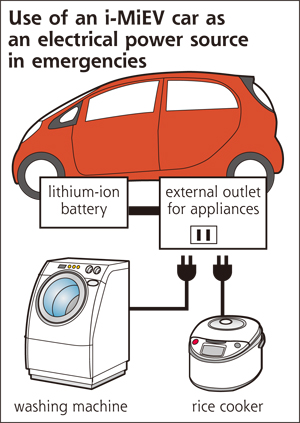Ask most people which car would be best to have in a disaster and they’re likely to name something like a Humvee.
While the now deceased gas-guzzling Humvee be good for navigating through deserted streets and clearing obstacles in the road it can’t help you cook a meal.
But it turns out plug in cars can.
Spurred on by the desire to provide Japanese citizens with a portable power station to help keep themselves fed and their homes warm, in a disaster, Mitsubishi announced back in June that it was planning on developing an accessory for the 2012 Mitsubishi i which would turn it into a large emergency battery backup system.

Mitsubishi 'i' Emergency Power Supply
Now Nissan has picked up the idea, announcing it has a similar system in development which it will unveil early next month. The system will be designed to work in its 2012 Leaf hatchback.
The world’s largest automaker Toyota isn’t left out either. It announced earlier this week that it was working on offering a 100 Volt AC outlet in its Japanese market 2012 Prius, meaning the car’s combined battery pack and gasoline engine could provide enough electricity to keep a basic home running for up to two days on a full tank of gasoline.
Of course, providing electric cars with the ability to provide power back to a home isn’t a new idea, nor is it one specifically restricted to a natural disaster.

2011 Toyota Prius
Charging from the grid at night time when the power demand is the lowest, a plug-in vehicle equipped with an on-board AC power outlet can help level out the peaks in demand by allowing consumers to draw power to run their home at times when the power grid is most under strain.
There are no more details yet about Nissan’s AC outlet for the 2012 Nissan Leaf, but if Mitsubishi’s experiences are anything to go by in a post-earthquake Japan, emergency AC power might be a permanent fixture of future plug-in vehicles.
[Bloomberg, Wards]












